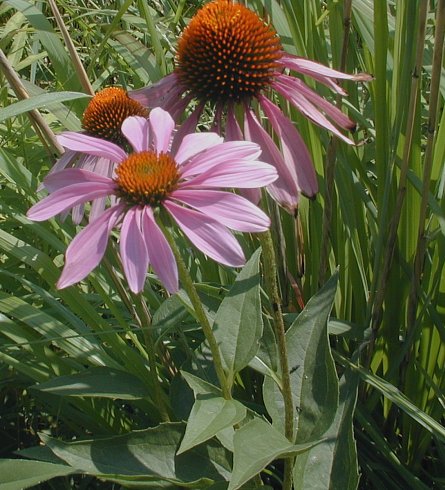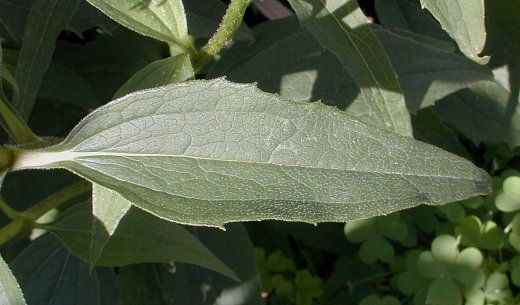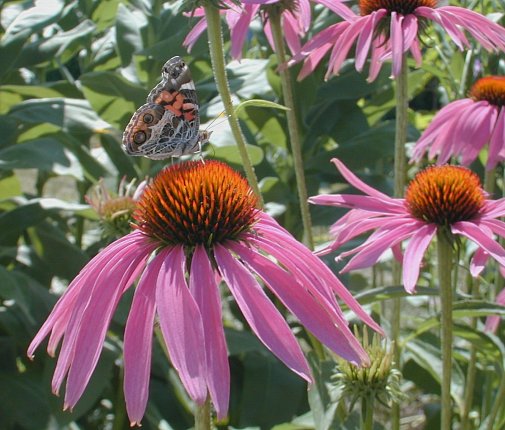Description: This is a perennial plant up to 3½' tall that branches occasionally. The light green stems have small purple streaks and scattered white hairs. The alternate or opposite leaves are up to 6" long and 3" across, becoming smaller as they ascend the stems. The leaves are ovate to lanceolate in shape and their margins have widely spaced teeth (or less often, they lack teeth). The upper leaf surface is olive or dark green with minute appressed hairs. The petioles are short and slightly winged.

Upper stems terminate in individual flowerheads spanning about 2½-4" across. These flowerheads have long naked peduncles (flowering stalks) up to 8" long; the peduncles have scattered hairs like the stems. Each daisy-like flowerhead has 10-20 ray florets that surround a large central cone of numerous disk florets. The central cone is yellowish brown to reddish brown, somewhat flattened, and very prickly. The petaloid rays are purple, narrowly oblong, and they tend to droop downward with age. Around the base of each flowerhead, there are numerous floral bracts (phyllaries) that are arranged in several layers. These bracts are green, hairy, and narrowly lanceolate, becoming recurved when the flowerhead blooms. The blooming period begins in mid-summer and lasts about a month, after which there is a temporary dormancy. Later, some plants may bloom again during the early fall. In bright sunlight, the flowerheads are mildly fragrant. Afterwards, the disk florets are replaced by dark achenes that are narrow and flat; they lack tufts of hair. At this time, the seedhead is prickly and dark-colored. The root system is fibrous and short-rhizomatous. Small dense colonies of plants may form from the rhizomes.

Cultivation:
The
preference is full to partial sun and moist to mesic conditions. Growth
is best in fertile loam, but the soil can contain some gravel or clay.
Foliar disease is rarely troublesome. While there is some drought
resistance, the entire plant will wilt if the soil becomes too dry,
particularly in strong sunlight. This plant is very easy to grow if the
preceding requirements are met.
Range & Habitat:
The native Purple Coneflower occurs primarily in central and NE
Illinois, and a few counties in southern Illinois (see Distribution
Map).
While often grown in gardens around homes and businesses, it is an
uncommon plant in the wild. However, Purple Coneflower is often used in
prairie restorations, where it may be locally common. Some populations,
particularly in the Chicago area, are probably plants that have escaped
from cultivation. Habitats include moist to mesic black soil prairies,
edges and openings in woodlands, savannas, thickets, and limestone
glades.

Faunal Associations: The flowers are cross-pollinated by long-tongued bees, bee flies, Halictid bees, butterflies, and skippers. Among long-tongued bees, are such visitors as honeybees, bumblebees, digger bees (Melissodes spp.), and leaf-cutting bees (Megachile spp.). Butterfly visitors include Monarchs, Fritillaries, Painted Ladies, Swallowtails, Sulfurs, and Whites. The caterpillars of the butterfly Chlosyne nycteis (Silvery Checkerspot) feed on the foliage, while the caterpillars of several moths feed on the flowerheads. These latter species include Chlorochlamys chloroleucaria (Blackberry Looper), Eupithecia miserulata (Common Eupithecia), Synchlora aerata (Wavy-Lined Emerald), and Homoeosoma electella (Sunflower Moth). A small songbird, the Eastern Goldfinch, occasionally eats the seeds during the summer and early fall.

Photographic
Location:
The photographs were taken at Meadowbrook Park in Urbana,
Illinois, and the webmaster's wildflower garden in the same city.
Comments:
This is a striking plant when it is in full bloom, as the flowers are
large and colorful. There is a cultivated form, called 'White Swan,'
that is often grown in flower gardens, but plants with white petaloid
rays are very rare in the wild. Purple Coneflower seems to attract more
than its fair share of butterflies, particularly in sunny, sheltered
areas. It can be distinguished from the similar Echinacea
pallida (Pale Purple Coneflower) by its broader leaves,
bushier habit, and later blooming period.